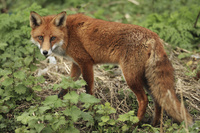Modern and ancient red fox (Vulpes vulpes) in Europe show an unusual lack of geographical and temporal structuring, and differing responses within the carnivores to historical climatic change [Photo: ©Andrew Kelly]



Female |
Male |
|---|---|
| Length 62-72cm; Tail length 40cm; Weight 5-7kg | Length 62-72cm; Tail length 40cm; Weight 5-7kg |
Photo: ©Andrew Kelly

A recent study using genome-wide data has suggested that the red fox may have naturally colonised Ireland in the early post-glacial period rather than being introduced by ancient humans as has previously been proposed.
The red fox has been the subject of predator control for many centuries. Traditionally it was hunted because it was known to be a poultry ‘thief’. More recently, the fox is still hunted to prevent livestock predation, for recreation and the commercial value of pelts. Despite this the red fox remains widespread across the Island of Ireland.

The red fox is found throughout Ireland. They are highly adaptable and can be found in various habitats, including urban areas.
The fox is not legally protected in Ireland due to its widespread distribution and abundance throughout the island — and has been the subject of predator control for many centuries.

The red fox is an easily recognisable Irish mammal, being dog-like, with a slender muzzle and long, horizontally-held bushy tail.
Foxes are similar in size to a medium-sized dog with orange-red fur on its back and sides and white fur on its underside. They have black tips to the ears, dark brown feet, and a white tip to its bushy orange tail. Evidence of fox activity can be found in various forms, including tracks, scat (droppings), prey remains and clumps of fur.
Foxes are most abundant in areas that offer a wide variety of food and cover. In contrast, areas of uniform land, such as moorland or open plains, generally carry much lower densities.
At high population densities, foxes generally have small home ranges and disperse over short distances. Some foxes become resident in an area and form stable home ranges, whilst others are nomadic and appear to wander from one place to another. Two crucial factors determining the size of a fox territory are the availability of food and the cost of defending the territory.
Foxes spend much of their time above ground but excavate underground dens called ‘earths’, which they use in bad weather to rear their young. In rural areas, the den can be in the form of an enlarged rabbit burrow, or occasionally, a chamber in a large badger sett is used. In undisturbed areas, the cubs may be born in long vegetation or under dry banks with overhanging vegetation.
The fox is recognised as a highly adaptable omnivore whose lack of dietary specialisation allows it to exploit various environments.
Foxes have been recorded feeding on items as diverse as sand eels, various types of fruit, earthworms, caterpillars, cabbages, and pet goldfish in garden ponds. The results of one fox diet study in Northern Ireland revealed that the two main components of the diet were sheep carrion and rabbit.
The red fox forms various sizes of family groups that range from monogamous pairs to small family groups.
These family groups usually consist of one dog fox and several related vixens, one of which will be the dominant female. The other females are usually the previous year’s offspring of the dominant vixen and, while non-breeding, may help to rear their half brothers and sisters by guarding, feeding and playing with them.
The dominant vixen comes into heat just once during the breeding season, which extends from December to February. The oestrus period lasts for three days, although mating may occur outside this period. Vixens are capable of conceiving 14 cubs in one litter, but in most cases, the average litter size is between four and five.
In Ireland, most cubs are born between March and mid-April. The vixen gives birth on bare soil, usually underground. They are born blind and deaf, but the eyes and ears open between 11 and 14 days, and for at least this period, the vixen stays with them constantly as they are unable to thermoregulate effectively. During this period, she is fed by the dog fox that returns to the den (the fox’s underground dwelling) and leaves the food at the entrance.
At approximately one month old, the cubs make their first venture above ground, staying close to the mouth of the den. They are gradually weaned from approximately six to ten weeks of age. The cubs' growth continues until early October when their size is much the same as that of the adults. They are independent by this stage but can still be encountered in family groups. The typical adult fur is acquired from about 18 weeks of age.
Although foxes have no natural predators, many die each year through a combination of disease, shootings, fox-hunting and other factors.
One of the biggest threats is traffic, with a significant number of foxes killed on roads each year. Mortality rates are especially high during the breeding season when foxes roam more widely and are more active, increasing their risk of accidents.
